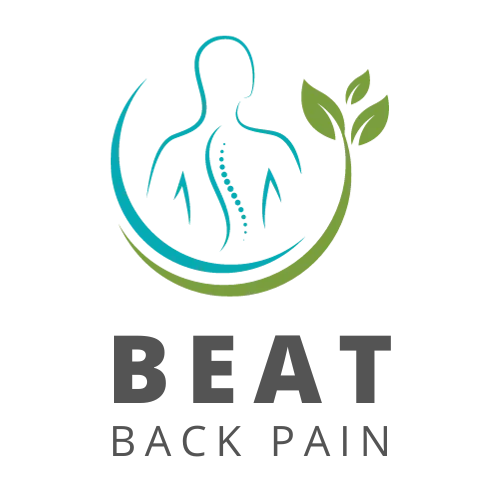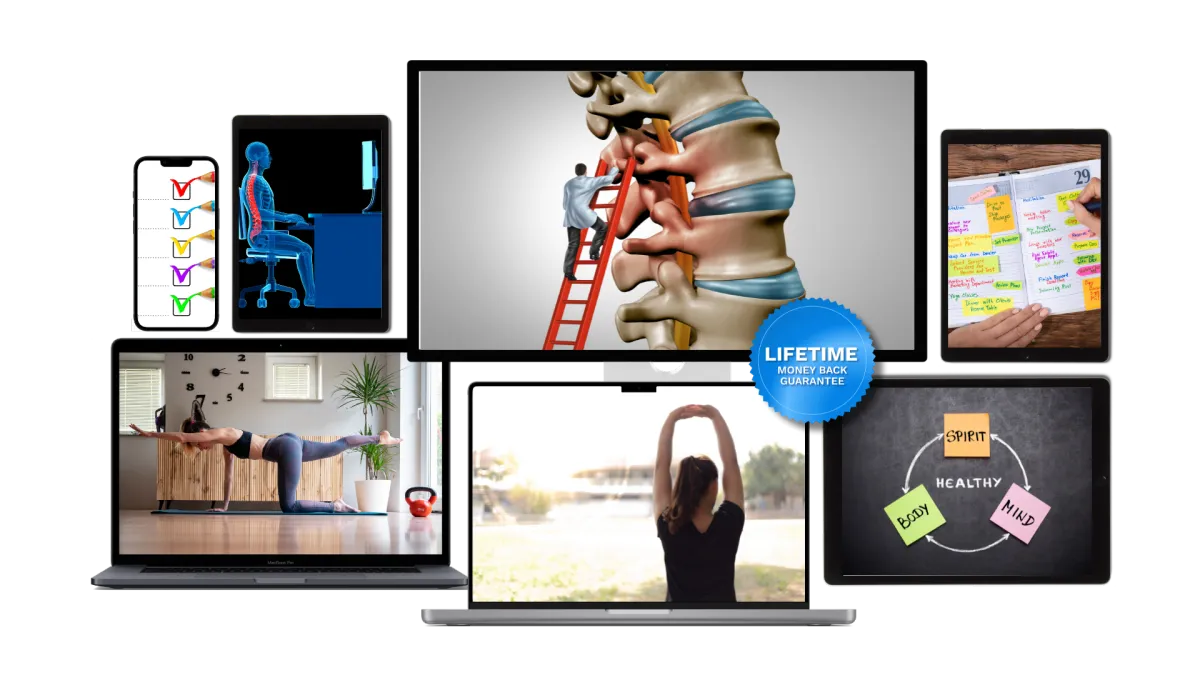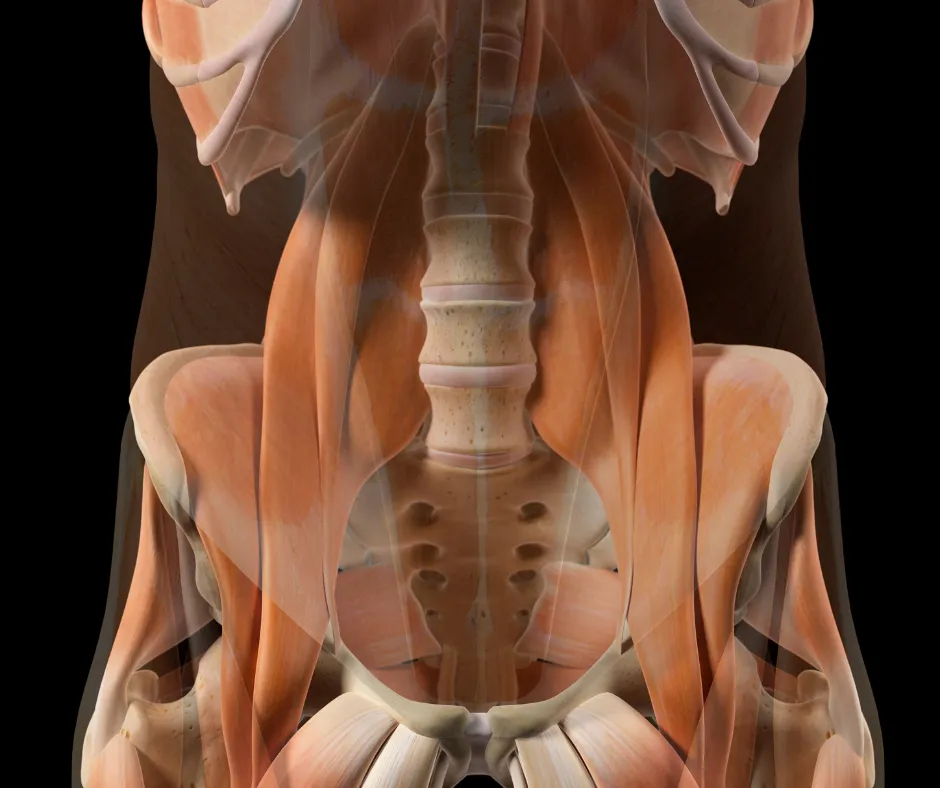
Warning: This Page Is For People Who Are Done With Temporary Back Pain Fixes.
If you’ve tried therapists, the painkillers, and useless YouTube stretches, but you still feel that familiar, nagging ache... this may be the most important page you ever read.
FROM: Peter Bennett
RE: Taking Back the Life Your Pain Has Stolen From You
Let's be brutally honest.
Your back pain is more than just a physical problem. It’s a thief.
It steals your ability to sleep through the night.
It steals your focus at work.
It steals your confidence to pick up your kids or grandkids.
It turns you into a "maybe next time" person, forcing you to sit on the sidelines of your own life.
You’ve become a prisoner in your own body, constantly calculating whether a simple movement is worth the painful price you’ll pay later.
And you’ve tried to fix it. Of course, you have.
You’ve paid the therapist $80 for a 5-minute crack that feels good for a day, only for the pain to creep back in.
You’ve downed painkillers that just mask the symptom, leaving the root cause to get worse.
You've bought the cushions, belts, and gadgets that now sit in a corner collecting dust.
The cycle is exhausting. And it's based on one massive lie.
You Don't Have a "Bad Back." You Have an Unsupported Back.
Your pain isn't a destiny. It's a symptom of a weak foundation. The muscles that are supposed to support your spine have become dormant, lazy, and weak from years of sitting, slouching, and incorrect movement.
Pills, adjustments, and massages are like patching a tire that has a slow leak. The fix is always temporary.
The ONLY permanent solution is to rebuild the foundation. To systematically reactivate and strengthen the muscles that form a natural, powerful brace around your spine.
That's why we created...
The 28-Day Spinal Reset System
This isn't a random collection of exercises. This is a strategic, week-by-week blueprint designed to take your back from a liability to a superpower.
It’s engineered to systematically rebuild your back's support system from the ground up, in just 15-20 minutes a day, without you ever leaving your living room.

Only: $27

Here’s Everything You Get Inside The 28-Day Spinal Reset System ...

The Core Program: The 28-Day Spinal Reset System (A $297 Value)
This is the step-by-step, follow-along video program that does the thinking for you. We will guide you through four progressive weeks of exercises that safely and effectively build strength, stability, and resilience.
Week 1: Activation - We gently wake up the deep, dormant core and glute muscles that have been "asleep" for years.
Week 2: Stabilisation - We teach those newly-activated muscles to work together to protect your spine during movement.
Week 3: Strengthening - We begin adding functional strength, building a powerful, supportive corset of muscle.
Week 4: Bulletproofing - We solidify your gains, creating a strong, resilient back that can handle the demands of everyday life without fear.
But that’s not all…
I want to make this decision so easy for you that you'd feel silly saying no. So I'm not just giving you the core system. I'm also adding 5 game-changing bonuses to accelerate your results and eliminate pain from every angle.
[GIFT #1]
BONUS #1: The Trigger Point Eraser: Your On-Demand Pain Relief Map (A $97 Value)
Got a deep, nagging knot that won't go away? This guide shows you how to find the exact hidden trigger points that refer pain to your low back and release them yourself in under 3 minutes for immediate relief.
GIFT #2]:
BONUS #2: The Gravity Reversal Method (A $67 Value)
Years of gravity and slouching have compressed your spine. This simple "Wall Align Technique" takes just 3 minutes to instantly decompress your vertebrae and reset your posture, taking pressure off your discs.
GIFT #3]
BONUS #3: The Flare-Up Rescue Protocol (A $127 Value)
Even with the best plan, life happens. This is your "break glass in case of emergency" routine. A series of gentle, safe stretches to calm a sudden chronic pain flare-up and stop it from spiraling out of control.
GIFT #4]:
BONUS #4: The Back Pain Bible: Peter's Unfiltered Guide (eBook) (A $47 Value)
In his book, Practical Tips for Low Back Pain Relief, Peter reveals the core principles for living a pain-free life. Understand the "why" behind the system and arm yourself with knowledge the specialists don't have time to teach you.
GIFT #5]
BONUS #5: The Pain-Proof Lifestyle Cheatsheet (A $47 Value)
We’ve distilled the most critical daily habits into a single page. Learn the right way to sleep, sit, bend, and lift to stop unknowingly damaging your back and protect your progress forever.
Let's Look At The Incredible Value You're Getting:
The 28-Day Spinal Reset System ($297 Value)
BONUS #1: The Trigger Point Eraser ($97 Value)
BONUS #2: The Gravity Reversal Method ($67 Value)
BONUS #3: The Flare-Up Rescue Protocol ($127 Value)
BONUS #4: The Back Pain Bible eBook ($47 Value)
BONUS #5: The Pain-Proof Lifestyle Cheatsheet ($47 Value)
Total Value: $682
Given that this system can save you thousands of dollars in future chiropractor visits, physical therapy, and useless gadgets, you can see why $197 would be a completely fair price.
But I’m not going to ask for $197.
Or $97.
Or even $47.
For a limited time, you can get the entire 28-Day Spinal Reset System and all 5 bonuses...
For A Single, One-Time Payment of Just $27
Why so ridiculously low?
Because frankly, my mission is to get this into the hands of as many people who are suffering as possible. I know that if I make this an absolute no-brainer, the testimonials and word-of-mouth will be worth more than charging a higher price upfront.
And to prove this isn't some gimmick, I'm going to take on 100% of the risk.
My Unconditional "Pain-Free or It's FREE" Guarantee

Click The Button Below To Get Instant Access Now
There Are Two Paths You Can Take Right Now:
Do Nothing. Click away from this page and continue down the same path of pain, frustration, and temporary fixes, hoping that things will magically get better on their own.
Take Action. Make a tiny, risk-free investment in yourself today. Get a proven, step-by-step system for rebuilding your back, and be protected by a guarantee that makes it impossible for you to lose.
The choice seems obvious to me.
P.S. Let’s put this in perspective. You could spend $27 on a few fancy coffees, a bottle of painkillers that hurts your liver, or one-third of a single chiropractic adjustment. Or you can invest it in a permanent solution you can use for the rest of your life.
With my "Pain-Free or It's Free" guarantee, you have absolutely nothing to lose. Click the button above and let's start rebuilding your back, together.
Who Am I To Help You Beat Back Pain?

Hey, Peter Bennett here…
For over 20 years I have helped people struggling with debilitating back pain.
Although I was getting great results for my clients in my clinic I was frustrated that I couldn't help all those people who live too far away.
After tirelessly researching, consulting experts, and experimenting with various techniques I uncovered a comprehensive approach to managing and preventing back pain from home and created "Beat Back Pain"
Now, I've gone on to help hundreds more people achieve a life free of back pain.
And if you’re ready to get started right away, I invite you to join this transformative journey.

Here’s a Few Answers to Common Questions I Get About The 28-Day Spinal Reset System
I have chronic back pain. Will this course be too basic or not specific enough for my condition?
Absolutely not! "The 28-Day Spinal Reset System" is designed to cater to a wide range of back pain sufferers, including those with chronic issues. The course provides detailed insights into understanding your specific type of pain and tailoring the exercises and strategies to meet your individual needs. Plus, it includes advice on when to seek professional medical guidance, ensuring you're on the right track to managing your chronic back pain safely and effectively.
I've tried many solutions before. How fast will I see results with "The 28-Day Spinal Reset System"?
The beauty of "The 28-Day Spinal Reset System" lies in its focus on quick relief techniques. Many of our clients report feeling a difference in their pain levels within the first few days of applying the strategies taught in the course. However, it's important to remember that every individual is different, and long-term relief comes with consistent practice of the techniques over time.
I don't have access to a lot of exercise equipment or a gym. Can I still benefit from this program?
Absolutely! "The 28-Day Spinal Reset System" is designed with accessibility in mind. All exercises and techniques can be performed at home with minimal or no equipment. We focus on easy-to-follow, practical exercises that utilise your body weight and everyday items, ensuring everyone can participate and benefit, regardless of their access to specialised equipment or a gym.
I've recently had back surgery. Can I use The 28-Day Spinal Reset System for my recovery?
While "The 28-Day Spinal Reset System" offers valuable insights and techniques for general back pain relief, it is not specifically tailored for those who are recovering from back surgery. Post-surgical back conditions often involve unique challenges such as scar tissue and altered biomechanics that require specialised, professional medical guidance. We strongly recommend consulting with your healthcare provider or a physical therapist to get a recovery plan that's specifically designed for your post-surgical needs. Our course can be a supplementary resource, but it should not replace personalised medical advice and rehabilitation programs for post-surgical recovery.

The Effects of Sitting on Hip Muscles and How It Leads to Back Weakness and Pain
The Effects of Sitting on Hip Muscles and How It Leads to Back Weakness and Pain
Sitting for long hours has become the norm in today's lifestyle, whether it's at work, during a long commute, or relaxing at home. However, what many people don’t realise is that prolonged sitting has a profound impact on the muscles around the hips, leading to back weakness and pain. Over time, this sedentary behaviour creates muscular imbalances that can disrupt posture, movement patterns, and overall health.
In this article, we’ll explore how sitting affects the hip muscles, the concept of reciprocal inhibition, and how activating the glutes can help release tight hips and alleviate back pain.
Outline:
Introduction
How Sitting Affects Hip Muscles
The problem with prolonged sitting
Muscle imbalances caused by sitting
Understanding Reciprocal Inhibition
How Weak Hips Lead to Back Pain
The kinetic chain connection
The role of the glutes in spinal support
Signs and Symptoms of Weak Hip Muscles
The Importance of Glute Activation
Exercises to Strengthen Glutes and Release Hips
Glute bridges
Hip thrusts
Dynamic stretches
Postural Changes to Prevent Pain
Conclusion
FAQs
How Sitting Affects Hip Muscles
The Problem with Prolonged Sitting
Sitting for extended periods causes the hip flexor muscles, primarily the iliopsoas, to become tight and overactive. This tightness results in a forward pull on the pelvis, creating an anterior pelvic tilt, which places excessive strain on the lower back.
Additionally, because the hips remain in a shortened position for too long, the glute muscles, which are responsible for hip extension, become weak and inactive—a condition often referred to as gluteal amnesia.
Muscle Imbalances Caused by Sitting
Sitting-induced muscle imbalances lead to:
Tight hip flexors – The iliopsoas shortens, pulling the pelvis forward.
Weak glutes – The gluteus maximus becomes underused, leading to instability.
Lower back compensation – The lumbar spine takes on unnecessary stress, leading to pain.
Understanding Reciprocal Inhibition
Reciprocal inhibition is a fundamental neuromuscular concept that describes how muscles on one side of a joint relax when the muscles on the opposite side contract.
For instance, when the hip flexors are tight and overactive due to excessive sitting, the glutes (which are antagonists to the hip flexors) become inhibited and weak. This means that without intentional activation of the glutes, the hip flexors will remain tight, perpetuating the cycle of pain and weakness.
In simple terms, if you don't activate your glutes, your hips stay tight, and your lower back suffers the consequences.
How Weak Hips Lead to Back Pain
The Kinetic Chain Connection
The body works as a kinetic chain, meaning that when one part is affected, the entire system is impacted. Weak glutes and tight hip flexors force the lower back to take on more responsibility than it should, leading to pain and dysfunction.
The Role of the Glutes in Spinal Support
The glutes play a critical role in maintaining pelvic alignment and spinal stability. Strong glutes help:
Reduce lumbar stress by supporting the pelvis
Prevent excessive anterior pelvic tilt
Maintain proper posture during movement
Signs and Symptoms of Weak Hip Muscles
If you've been sitting too much and have weak hip muscles, you may experience:
Lower back pain – Due to increased stress on the lumbar spine
Tightness in the hips – Making it difficult to stand upright
Poor posture – Leading to a slouched or anterior-tilted position
Difficulty in movements – Such as squatting or running
The Importance of Glute Activation
To break the cycle of pain and weakness, it’s essential to activate and strengthen the glutes. Strong glutes can help:
Counteract tight hip flexors
Improve pelvic alignment
Support lower back function
Enhance movement efficiency
Exercises to Strengthen Glutes and Release Hips
Here are some powerful exercises to strengthen the glutes and release the hips:
1. Glute Bridges
How to do it:
Lie on your back with knees bent and feet hip-width apart.
Squeeze your glutes and lift your hips towards the ceiling.
Hold for 2 seconds and lower back down.
Benefits: Activates the glutes while stretching the hip flexors.
2. Hip Thrusts
How to do it:
Sit against a bench with your upper back resting on it.
Place a weight on your hips and thrust them upwards.
Lower slowly and repeat.
Benefits: Builds glute strength and improves hip extension.
3. Dynamic Hip Flexor Stretch
How to do it:
Kneel on one knee with the other foot forward.
Push your hips forward gently while squeezing your glutes.
Hold for 30 seconds per side.
Benefits: Opens up tight hip flexors while encouraging glute engagement.
4. Clamshells
How to do it:
Lie on your side with knees bent.
Open your knees apart while keeping your feet together.
Slowly return to the start position.
Benefits: Strengthens the glute medius, improving hip stability.
Postural Changes to Prevent Pain
In addition to exercise, improving daily posture can prevent back pain:
Take breaks from sitting – Stand up and stretch every 30-60 minutes.
Use ergonomic furniture – Ensure your chair and desk promote good posture.
Engage your core – Keep your abdominal muscles slightly engaged while sitting.
Avoid crossing legs – It can contribute to hip imbalances.
Conclusion
The modern lifestyle of prolonged sitting can wreak havoc on your hip muscles, leading to back weakness and pain. However, understanding reciprocal inhibition and actively working to strengthen the glutes can help break the cycle of hip tightness and back discomfort. By incorporating targeted exercises and postural adjustments into your routine, you can restore balance, improve mobility, and prevent future pain.
FAQs
1. How does sitting affect my hip muscles?
Sitting shortens the hip flexors and weakens the glutes, leading to imbalances and pain.
2. What is reciprocal inhibition?
It's a neuromuscular concept where contracting one muscle group leads to the relaxation of its opposing muscle group.
3. Can strengthening my glutes help with back pain?
Yes, stronger glutes support proper pelvic alignment, reducing lower back stress.
4. How often should I do glute activation exercises?
Aim for at least 3-4 times a week for optimal results.
5. Are there other lifestyle changes to prevent back pain?
Yes, maintaining good posture, stretching, and staying active can help prevent back issues.

Privacy Policy | Terms & Conditions | Disclaimer
Having issues ordering? Email peter@yourspinalhealth.com
